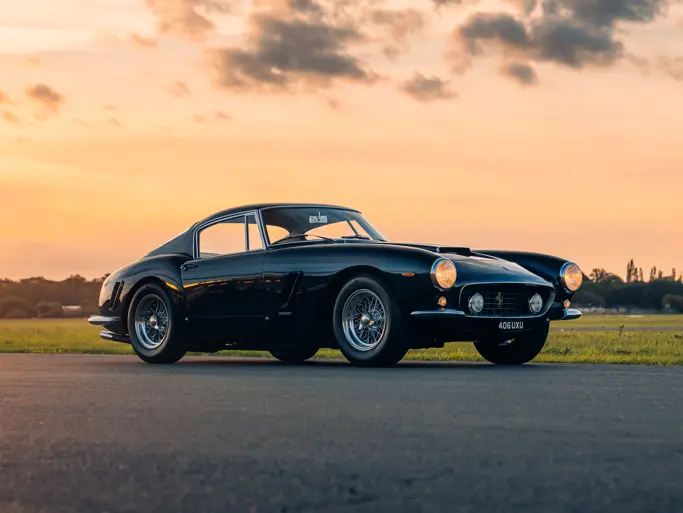300 bhp, 3,967 cc SOHC V-12 engine with three Weber 40 DCZ/6 carburettors, five-speed manual gearbox, independent unequal-length wishbone front suspension with coil springs, live rear axle with semi-elliptical leaf springs and coil springs over telescopic shock absorbers, and four-wheel dual-circuit Dunlop disc brakes. Wheelbase: 104 in
The 330 GT 2+2, created to replace the 250 GT/E and interim 330 America, was not announced at a major auto show, but rather at the company’s annual pre-season competition press conference in January 1964. The car was formally introduced to the world the following month at the Brussels Salon, and its bodywork was both designed and built by Pininfarina, exhibiting a number of differences over Ferrari’s two previous four-seater models. Along with a distinctive quad-headlight front end, the 330 GT 2+2 boasted a wheelbase that was 50 millimetres longer than its predecessors, as well as a Dunlop dual-circuit braking system and Koni adjustable shock absorbers.
Ferrari gave the 330 GT 2+2 a number of updates halfway through the 1965 model year, in an effort to further attract buyers. The most noticeable change to the 330 GT 2+2, later dubbed the Series II, was a restyled front end, which replaced the four-headlight nose with a more attractive two-headlight design. Along with the inclusion of different side louvers, installed for better engine ventilation, the overall look was very similar in style to the 275 GTS. Additionally, 10-hole alloy wheels were fitted as standard to Series II cars. A number of small changes were made to the car’s exterior as well, including a redesigned transmission tunnel that was connected to the central dashboard, necessitating further changes to the location of the dashboard switchgear.
Chassis 08319 GT, born as a Series II 330 GT 2+2, was completed by the factory in March 1966; at that time, it was finished in Bianco (20414 A) over a Rosso (VM 3171) leather interior and was equipped with power windows. Later that year, the car was delivered new to its first owner through Rugico S.A., Spain’s official Ferrari distributor. Although the car’s early history is unknown, by 1985 it had relocated to Italy, where it was purchased by Fulvio Sperone, of Moncalieri. It is believed that the car remained with him for over 15 years before ownership was transferred to Mrs Angela Rubeo, also of Moncalieri, in 2001, according to Ferrari historian Marcel Massini. By this time, the car had been refinished in dark blue, yet it is believed to still be retaining its original Rosso interior.
It was sold in November 2002 to another female owner, Maria Sterpeta Francavilla of Torino. The following year, it is noted that the car was involved in an accident and the damage to the passenger-side front of the car was repaired shortly thereafter in Italy. The car has stayed in Italy ever since and remains in wonderful condition, ready to drive and enjoy.
These cars feature numerous desirable upgrades over the Series I 330 GT 2+2 and are just as wonderful to drive as they are to look at. For the enthusiast with a family of four looking to enjoy the finer points of Enzo-era Ferrari ownership, look no further.

 | London, United Kingdom
| London, United Kingdom


